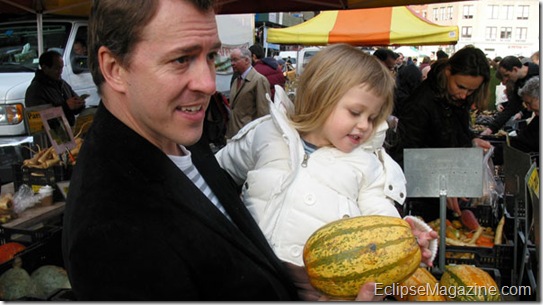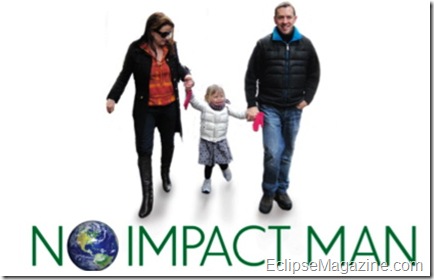Could you live a life that has absolutely no impact on the environment? I’m not talking about recycling the occasional plastic water bottle or rocking the Prius. No, I’m talking going all the way, only using your bicycle, walking up stairs at work, going without electricity, not using toilet paper or diapers, only eating vegetables grown locally and other things. I tell you now, I couldn’t and wouldn’t do it, but there’s someone who did just that – Colin Beavan, known as the No Impact Man did just that. He dragged his wife Michelle Conlin a Journalist for Business Week who loves her lattes and gucci. I recently had a good telephone interview with Documentary Justin Schein.
I’m curious how did you get involved in this project?
I made the film with a co-director who was a long time friend of Michelle. We had dinner with them about a week before the project started. I’m a documentary filmmaker who was interested in the environment, but I’m more of a character driven filmmaker and I thought Colin and Michelle would be interesting characters to follow
What was it about these people that attracted you?
Knowing Colin and Michelle, we knew that they were an interesting team. Michelle in particular we knew she wasn’t as onboard as fully as Colin was. She was really funny and Colin made the straight man to her humor. He wasn’t on board with the film at the beginning; it was more Michelle’s idea. He saw the year as a respite from the crazy New York Lifestyle. Having a camera in his face was scary to him. One of the conditions was he wanted the shoot to be as environmentally friendly as possible. He didn’t want to be responsible for a group of filmmakers following him around. So he said he wanted us to have as low an impact as possible.
This forced us to think a bit outside the box. We decided not to buy a new camera, not to use lights and use as much natural lighting as possible and we didn’t use any cars. I took the subway to film with him and I tried to shoot him on bicycles from my bike.
How difficult was it to film in an environmentally friendly way?
Documentary filmmaking is so much more of a low impact thing than feature films. We use wireless mics, no sound people, and use rechargeable batteries for all our gear. The project taught me as a person that we really need to ask ourselves how we can improve the quality of the environment. It brings up a lot of different questions.
How do you think Michelle and Colin change throughout the course of the year?
Michelle, as I said, had a longer way to go. The changes I saw in Colin was more subtle, he started changing his rules. He began to see that the individual changes were important, but it was more important to become more involved in the community. Colin was really a catalyst for Michelle.
Did this project impact how you feel about the environment?
You can’t spend a year or more with people that are really trying to cut back their footprint without asking the same questions yourself. We had a baby and started using cloth diapers, we joined a community food coop and started line-drying our clothes, we compost our waste now. The biggest change is that I have become more aware of my impact. I ride my bike a lot more now. It’s important to model our behavior; we’re relatively liberal New Yorkers. I think we’re in a real environmental emergency and that we’re going to have to change. We’re teetering on the edge of difficult time.
How do you go through the process of deciding how far to go?
Colin said that this is an extreme example. Part of deciding what to change is just common-sense. Like bringing a pop back to the supermarket instead of throwing the bottle away. The first step is just to answer questions about how we live, we hope this film serve as a catalyst for people to change. Nobody is going to spend a year doing this, but we hope people will spend a day or a week.
You’ve done over 20 documentaries. What is about the documentary format that attracts you?
I find it a great opportunity to explore subjects that interest me. I try to tell stories of places and people where you generally don’t go. I think everyone has a story to tell.
Yeah, but how do you go about telling this story? This is a year long project at some point it’s going to be boring and there will be a lot of film shooting these long stretches where nothing happens.
The film itself, the first 75% of the film is the first three months of the project because that’s where the dramatic change happens. It’s just a story telling and editing issue. They had a whole water phase that didn’t make the cut. We had over 150 hours of footage that was shot over 15 months. Professionally I always have over 5 projects going at once.
Where you there 24/7? How often did you shoot?
We shot pretty sporadic. Colin and Michelle are storytellers themselves, they understood that we needed some drama. They were very helpful with letting us know what was going. They also did a bunch of tasks, which let us have something to film.
What’s been the response in the environmental community?
Colin at first was both from the right and left as being too unrealistic. From the left people said he was too radical. Lately he’s been getting a lot of positive feedback from Christians. A lot of people we’ve shown the film too has come up to us.
What are you working on now?
I’m working on two different projects. I’m working on a film that’s part animated and part film that’s about dyslexia. I’m working with Mayer Vishner who was a community farmer in the movie No Impact Man. He’s an aging activist and critical of the movie. No Impact Man is playing now. Check out the official website.
EM Interview
By Michelle Alexandria
Originally posted 9.26.09

